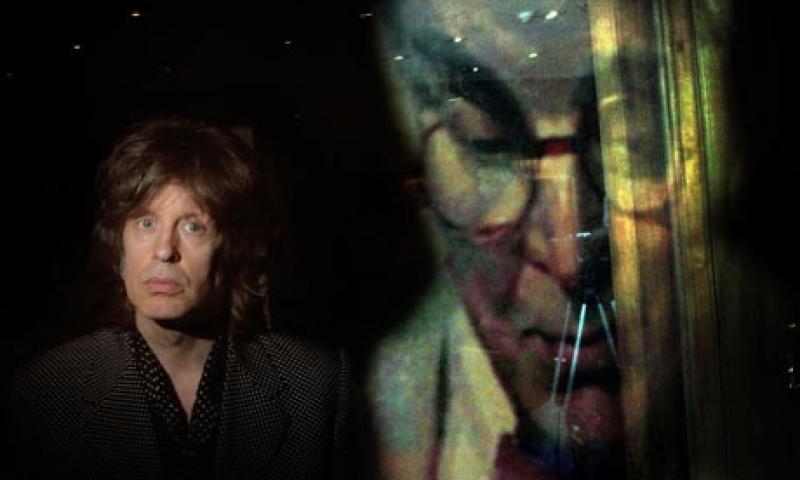My Summer Reading: Musician Mike Scott | reviews, news & interviews
My Summer Reading: Musician Mike Scott
My Summer Reading: Musician Mike Scott
A trio of best-selling thrillers and an absorbing portrait of evil

Born in Edinburgh in 1958, musician, singer and songwriter Mike Scott has been the leader of the rock band The Waterboys for almost three decades. Perhaps best known for the sky-scraping hit single “The Whole of the Moon”, on albums such as Fisherman’s Blues, This is the Sea and Book of Lightning, Scott has consistently reinvented the band's sound, fusing folk, rock and pop and working with a changing cast of musicians.
He currently lives in Dublin, where earlier this year over five nights at the Abbey Theatre he premiered the latest Waterboys project, An Appointment with Mr Yeats, which adapts 20 poems by W B Yeats in a variety of new musical settings. The show won considerable critical acclaim and will be touring later this year.
I’ve just finished Stieg Larsson's Millennium trilogy [The Girl With the Dragon Tattoo, The Girl Who Played with Fire, The Girl Who Kicked the Hornets' Nest], which took me a week. Someone recommended them to me via Twitter. The characters were believable, the plots good, the unravelling of them exciting.
 [Extract from The Girl Who Kicked the Hornets' Nest by Stieg Larsson (Quercus, 2009)]
[Extract from The Girl Who Kicked the Hornets' Nest by Stieg Larsson (Quercus, 2009)]
Mikael Blomkvist looked up at the clock and saw that it was just after 3.00 in the morning. He was handcuffed and increasingly uncomfortable. He was dead tired but running on adrenaline. He opened them again and gave the policeman an angry glare. Inspector Thomas Paulsson had a shocked expression on his face. They were sitting at a kitchen table in a white farmhouse called Gosseberga, somewhere near Nossebro. Blomkvist had heard of the place for the first time less than twelve hours earlier.
There was no denying the disaster that had occurred.
“Imbecile,” Blomkvist said.
“Now you listen here – “
“Imbecile,” Blomkvist said again. “I warned you he was dangerous, for Christ’s sake. I told you that you would have to handle him like a live grenade. He’s murdered at least three people with his bare hands and he’s built like a tank. And you send a couple of village policeman to arrest him as if he were some Saturday night drunk.”
Blomkvist shut his eyes again, wondering what else could go wrong that night.
He had found Salander just after midnight. She was very badly wounded. He had sent for the police and the Rescue Service.
The only thing that had gone right was that he had persuaded them to send a helicopter to take the girl to Sahlgrenska hospital. He had given them a clear description of her injuries and the bullet wound in her head, and some bright spark at the Rescue Service got the message.
Even so, it had taken over half an hour for the Puma from the helicopter unit in Save to arrive at the farmhouse. Blomkvist had got two cars out of the barn. He switched on their headlights to illuminate a landing area in the field outside of the house.
The helicopter crew and two paramedics had proceeded in a routine and professional manner. One of the medics tended to Salander while the other took care of Alexander Zalachenko, known locally as Karl Alex Bodin. Zalachenko was Salander’s father and her worst enemy. He had tried to kill her but he had failed.
I spent the summer of 1999 reading The Rise and Fall of the Third Reich by William L Shirer, plus the cluster of other books Shirer wrote about the rise of the Nazis (Berlin Diary, This is Berlin). Good light, breezy stuff... not. But wholly absorbing.
There's something about the moral certainty of reading about characters as vile as Hitler and his gangsters, it's reassuring in a way. And that degree of evil, though banal, as is often pointed out, is fascinating. Shirer was a robust, courageous writer who was able to stand in its midst and tell it as he saw it [the book was written in 1960]. His books are a brilliant, compelling document.
 [Extract from The Rise & Fall of the Third Reich: a History of Nazi Germany by William L Shirer, pp 1-2 (Arrow Books 1991)]
[Extract from The Rise & Fall of the Third Reich: a History of Nazi Germany by William L Shirer, pp 1-2 (Arrow Books 1991)]
On the very eve of the birth of the Third Reich a feverish tension gripped Berlin. The Weimar Republic, it seemed obvious to almost everyone, was about to expire. For more than a year it had been fast crumbling. General Kurt von Schleicher, who like his immediate predecessor Franz von Papen cared little for the Republic and less for its democracy, and who, also like him, had ruled as Chancellor by presidential decree without recourse to Parliament, had come to the end of his rope after 57 days in office.
On Saturday, January 28, 1933, he had been abruptly dismissed by the ageing President of the Republic, Field Marshal von Hindenburg. Adolf Hitler, leader of the National Socialists, the largest political party in Germany, was demanding for himself the chancellorship of the democratic Republic he had sworn to destroy.
The wildest rumours of what might happen were rife in the capital that fateful winter weekend, the most alarming of them, as it happened, were not without some foundation. There were reports that Schleicher, in collusion with General Kirt von Hammerstine, the Commander in Chief of the Army, was preparing a putsch with the support of the Potsdam garrison for the purpose of arresting the President and establishing a military dictatorship. There was talk of a Nazi putsch. The Berlin stormtroopers, aided by Nazi sympathisers in the police, were to seize the Wilhelmstrasse, where the President’s Palace and most of the government ministries were located. There was talk also of a general strike. On Sunday, January 29, 100,000 workers crowded into the Lustgarten in the centre of Berlin to demonstrate their opposition to making Hitler Chancellor. One of their leaders attempted to get in touch with General von Hammerstein to propose joint action by the Army and organised labour should Hitler be named to head a new government. Once before, at the time of the Kapp putsch in 1920, a general strike had save the Republic after the government had fled the capital.
Throughout most of the night from Sunday to Monday Hitler paced up and down his room in the Ksierhof hotel on the Reichskanzlerplatz, just down the street from the Chancellery. Despite his nervousness he was supremely confident that his hour had struck. For nearly a month hd had been secretly negotiating with Papen and the other leaders of the conservative Right. He had had to compromise. He could not have a purely Nazi government. but he could be Chancellor of a coalition government whose members, eight out of 11 of whom were not Nazis, agreed with him on the abolition of the democratic Weimar regime.
For a musician like me, most summers are spent not on holiday but performing at rock festivals. I like a good read while I'm travelling with The Waterboys; there are often long days of multiple flights or of waiting around in hotels, and a good book fills the time. I recently travelled to Portugal with my nose in Checker and the Derailleurs by Lionel Shriver (a novel about a New York band in the Eighties) and The Complete Cosmicomics by Italo Calvino; two very different books, and depending on my mood I'll pick one of them up.
- An Appointment with Mr Yeats is touring Ireland in November. Visit the Waterboys website for dates and tickets details.
- My Summer Reading: other guests include ballerina Tamara Rojo, songwriter Tom Russell, theatre designer Tobias Hoheisel, sculptor Cornelia Parker, dramatist Patrick Marber, dancer Carlos Acosta
Explore topics
Share this article
The future of Arts Journalism
You can stop theartsdesk.com closing!
We urgently need financing to survive. Our fundraising drive has thus far raised £49,000 but we need to reach £100,000 or we will be forced to close. Please contribute here: https://gofund.me/c3f6033d
And if you can forward this information to anyone who might assist, we’d be grateful.

Subscribe to theartsdesk.com
Thank you for continuing to read our work on theartsdesk.com. For unlimited access to every article in its entirety, including our archive of more than 15,000 pieces, we're asking for £5 per month or £40 per year. We feel it's a very good deal, and hope you do too.
To take a subscription now simply click here.
And if you're looking for that extra gift for a friend or family member, why not treat them to a theartsdesk.com gift subscription?
more New music
 Album: Boz Scaggs - Detour
Smooth and soulful standards from an old pro
Album: Boz Scaggs - Detour
Smooth and soulful standards from an old pro
 Emily A. Sprague realises a Japanese dream on 'Cloud Time'
A set of live improvisations that drift in and out of real beauty
Emily A. Sprague realises a Japanese dream on 'Cloud Time'
A set of live improvisations that drift in and out of real beauty
 Trio Da Kali, Milton Court review - Mali masters make the ancient new
Three supreme musicians from Bamako in transcendent mood
Trio Da Kali, Milton Court review - Mali masters make the ancient new
Three supreme musicians from Bamako in transcendent mood
 Hollie Cook's 'Shy Girl' isn't heavyweight but has a summery reggae lilt
Tropical-tinted downtempo pop that's likeable if uneventful
Hollie Cook's 'Shy Girl' isn't heavyweight but has a summery reggae lilt
Tropical-tinted downtempo pop that's likeable if uneventful
 Pop Will Eat Itself's 'Delete Everything' is noisy but patchy
Despite unlovely production, the Eighties/Nineties unit retain rowdy ebullience
Pop Will Eat Itself's 'Delete Everything' is noisy but patchy
Despite unlovely production, the Eighties/Nineties unit retain rowdy ebullience
 Music Reissues Weekly: The Earlies - These Were The Earlies
Lancashire and Texas unite to fashion a 2004 landmark of modern psychedelia
Music Reissues Weekly: The Earlies - These Were The Earlies
Lancashire and Texas unite to fashion a 2004 landmark of modern psychedelia
 Odd times and clunking lines in 'The Life of a Showgirl' for Taylor Swift
A record this weird should be more interesting, surely
Odd times and clunking lines in 'The Life of a Showgirl' for Taylor Swift
A record this weird should be more interesting, surely
 Waylon Jennings' 'Songbird' raises this country great from the grave
The first of a trove of posthumous recordings from the 1970s and early 1980s
Waylon Jennings' 'Songbird' raises this country great from the grave
The first of a trove of posthumous recordings from the 1970s and early 1980s
 Lady Gaga, The Mayhem Ball, O2 review - epic, eye-boggling and full of spirit
One of the year's most anticipated tours lives up to the hype
Lady Gaga, The Mayhem Ball, O2 review - epic, eye-boggling and full of spirit
One of the year's most anticipated tours lives up to the hype
 Slovenian avant-folk outfit Širom’s 'In the Wind of Night, Hard-Fallen Incantations Whisper' opens the door to inner space
Unconventional folk-based music which sounds like nothing else
Slovenian avant-folk outfit Širom’s 'In the Wind of Night, Hard-Fallen Incantations Whisper' opens the door to inner space
Unconventional folk-based music which sounds like nothing else
 'The Art of Loving': Olivia Dean's vulnerable and intimate second album
Neo soul Londoner's new release outgrows her debut
'The Art of Loving': Olivia Dean's vulnerable and intimate second album
Neo soul Londoner's new release outgrows her debut

Add comment